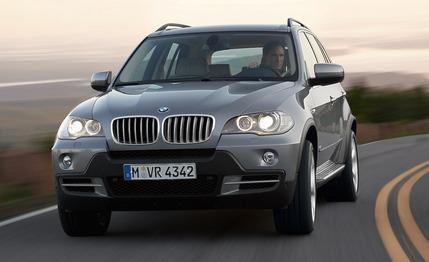 Review
Review
BMW’s X5 was one of the first to prove that a truck could dance through the twisties and reward an enthusiastic driver. It was a practical, four-season people mover that drove like a proper Bimmer. Granted, that first-generation Sports Activity Vehicle, or SAV, which debuted in 1999, also was a bit firm in the suspenders and lacked the cavernous cargo area of more traditional SUVs. And so the second-generation X5 attempts to address those ills with a more compliant yet still taut suspension and nearly eight inches of added length to accommodate an optional third row of seats. Whereas the addition of the X5 xDrive35d and its 265-hp, 3.0-liter turbo-diesel is the primary change for 2009—stay tuned for more on that model—we decided to take another look at the top-level xDrive48i outfitted with BMW’s 350-hp, 4.8-liter V-8.
Performance Is Relative, Even for a BMW
The last V-8 X5 we evaluated was similar to this particular example, albeit slightly less expensive due to the lack of the $3700 Sport package found on our tester. Although this model rolled on 19-inch all-season rubber versus the 20-inch summer-tire option, the addition of BMW’s electronic damper control suspension and sport seats and steering wheel made tossing around the 5200-pound behemoth rather pleasant. The feel from the helm is reminiscent of that in our long-term X6 xDrive50i, yet the absence of the X6’s torque-vectoring rear axle and twin-turbocharged 4.4-liter V-8—both of which we expect to migrate to the X5 relatively soon—make the seven-seater a mite less playful, and slower.
Although we hustled an xDrive48i to 60 mph in a tick over six seconds, it quickly became evident that the naturally aspirated engine has to work much harder than the X6’s blown mill. No surprise really, given the torque deficit of 100 lb-ft, but it illuminates the responsive nature of the company’s newer turbocharged and direct-fuel-injected engines. Neither vehicle is an exemplar of fuel economy—both averaged 15 mpg in our hands—but the X6’s 50 additional hp and 5.1-second 0-to-60 sprint are insults laid atop injury for the X5. Factor in the new xDrive35d diesel, which is less expensive than the V-8, only slightly slower, and carries a city/highway rating of 19/25 mpg, and it’s clear that the older X5 models are now a half-step behind their BMW brethren.
It’s a People Mover, Not an M5
The upcoming 550-hp X5 M will take much of the performance onus off the regular models, leaving BMW free to focus more on interior accommodations and packaging. And that’s a good thing, because the X5 could use some upgrades in that area, too. Although the cabin is comfortable and its build quality and materials are impressive, the latest version of iDrive is frustratingly absent and the third-row seats are but token accommodations. Our tester did without the rearmost chairs—which saves $1700 and allows for a decent 19 cubic feet of cargo room behind the second row—and our past experience has us convinced it’s better that way. In addition to the Sport package, other major options that drove the as-tested price up to $66,520 include a $2200 Premium package (power liftgate, digital compass, and auto-dimming mirrors), a $1900 navigation system, $1000 for keyless access, and $500 for heated seats.
The X5 may be showing its age, but it’s far from obsolete. It still drives better than most cars, is as solid as a vault, and is packed with luxury amenities and technology. We might not bite our lips at this example’s window sticker if it had the new iDrive interface, more power, and slightly better fuel economy—all of which are no-brainers if BMW plans to keep the X5 near the forefront of this segment. Of course, prices likely will increase with said improvements.